Employability Skills Report: Healthcare Center Performance Analysis
VerifiedAdded on 2023/01/18
|13
|4314
|46
Report
AI Summary
This report examines the critical aspects of employability skills within a healthcare center, focusing on four key tasks. Task 1 explores the development of personal responsibilities and performance objectives, evaluating effectiveness, making improvement recommendations, and reviewing motivational techniques. Task 2 delves into problem-solving, communication styles, and time management strategies. Task 3 analyzes team roles, dynamics, and alternative task completion methods. Finally, Task 4 evaluates tools and methods for problem-solving, strategy development, and the impact of implementation. The report highlights the importance of teamwork, communication, leadership, and time management for delivering quality patient care and achieving organizational goals. The report also discusses motivational techniques and provides recommendations for improvement, emphasizing the need for training, opportunity identification, and enhanced communication skills. The report concludes by emphasizing the importance of these skills for individual and organizational success in the healthcare sector.
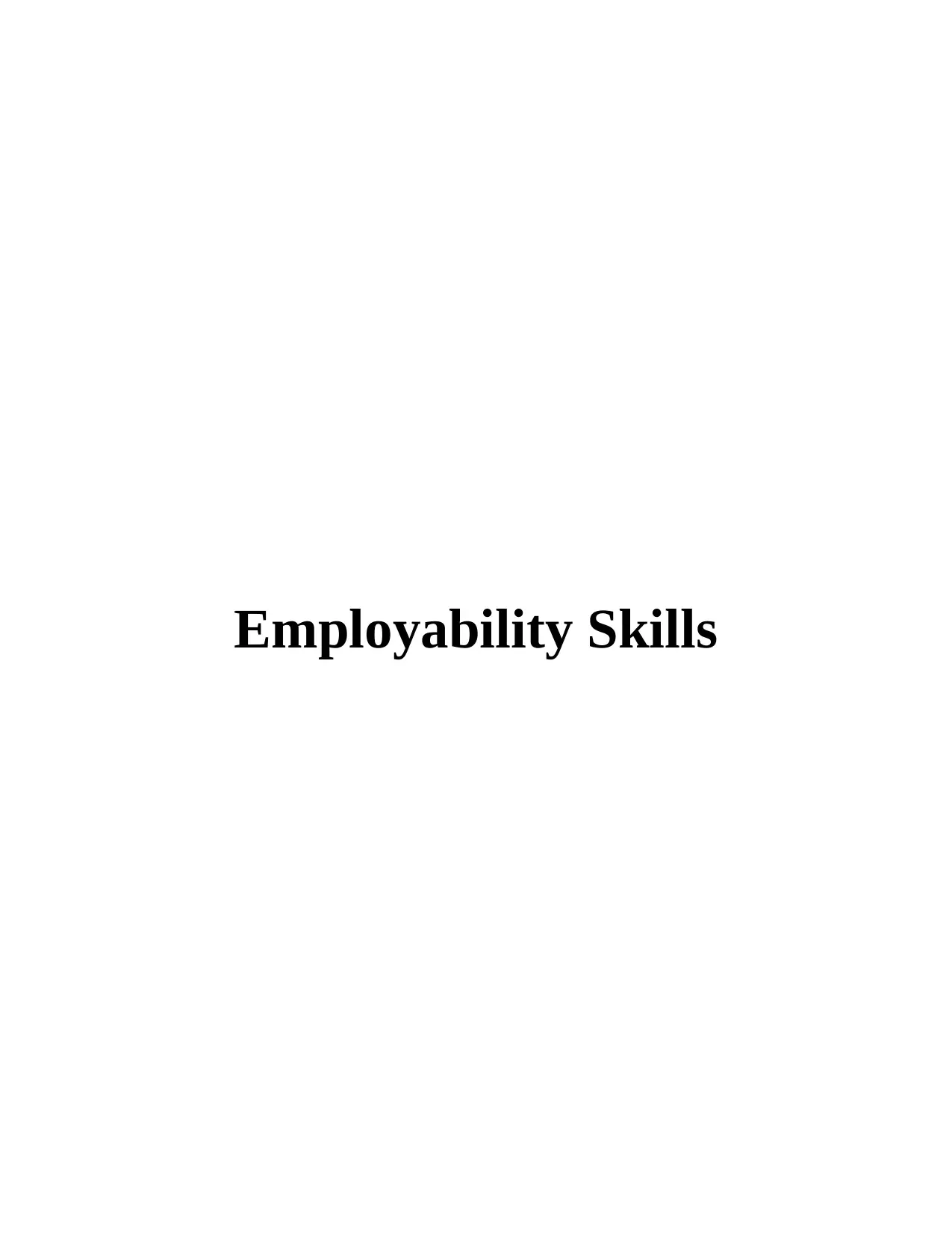
Employability Skills
Paraphrase This Document
Need a fresh take? Get an instant paraphrase of this document with our AI Paraphraser
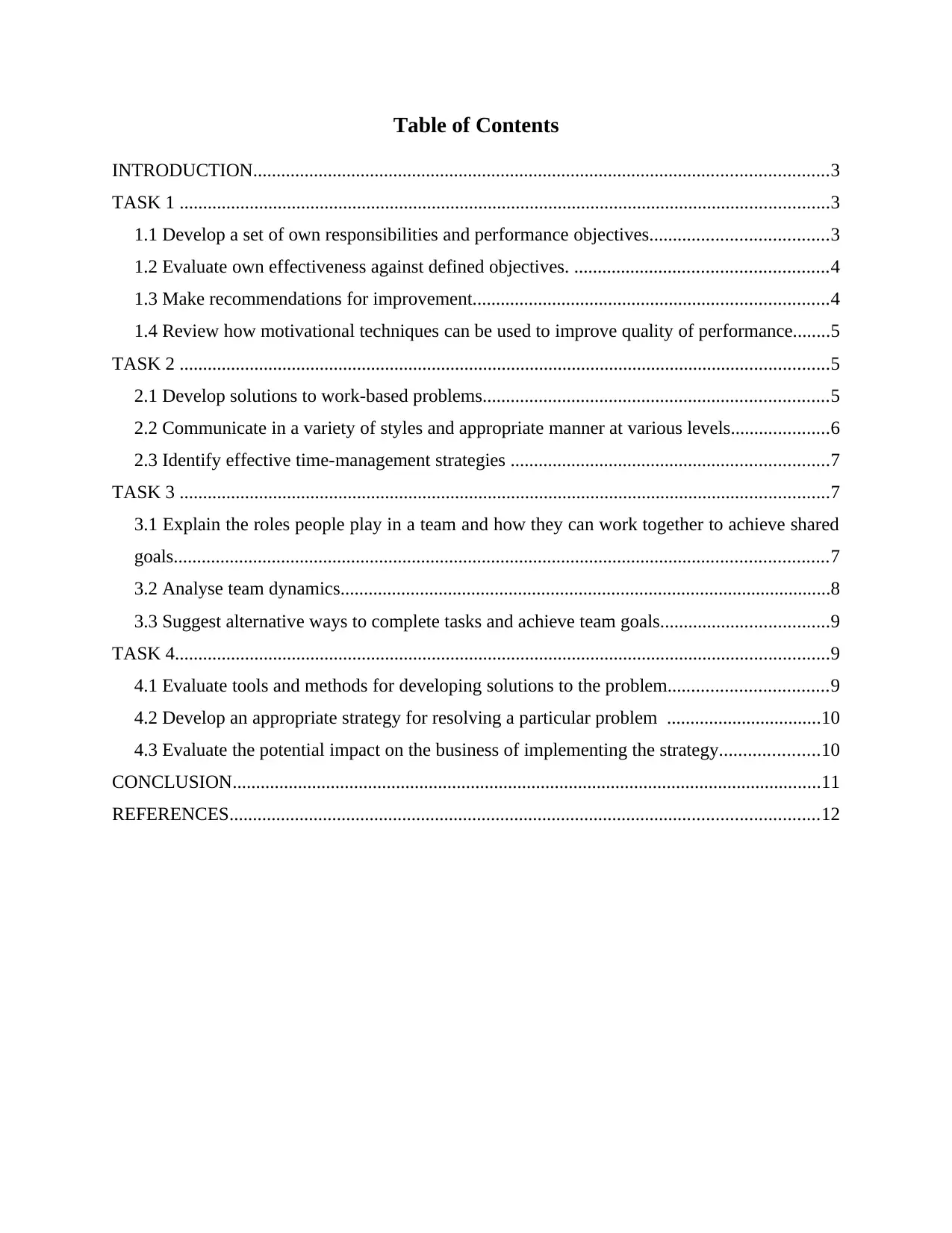
Table of Contents
INTRODUCTION...........................................................................................................................3
TASK 1 ...........................................................................................................................................3
1.1 Develop a set of own responsibilities and performance objectives......................................3
1.2 Evaluate own effectiveness against defined objectives. ......................................................4
1.3 Make recommendations for improvement............................................................................4
1.4 Review how motivational techniques can be used to improve quality of performance........5
TASK 2 ...........................................................................................................................................5
2.1 Develop solutions to work-based problems..........................................................................5
2.2 Communicate in a variety of styles and appropriate manner at various levels.....................6
2.3 Identify effective time-management strategies ....................................................................7
TASK 3 ...........................................................................................................................................7
3.1 Explain the roles people play in a team and how they can work together to achieve shared
goals............................................................................................................................................7
3.2 Analyse team dynamics.........................................................................................................8
3.3 Suggest alternative ways to complete tasks and achieve team goals....................................9
TASK 4............................................................................................................................................9
4.1 Evaluate tools and methods for developing solutions to the problem..................................9
4.2 Develop an appropriate strategy for resolving a particular problem .................................10
4.3 Evaluate the potential impact on the business of implementing the strategy.....................10
CONCLUSION..............................................................................................................................11
REFERENCES..............................................................................................................................12
INTRODUCTION...........................................................................................................................3
TASK 1 ...........................................................................................................................................3
1.1 Develop a set of own responsibilities and performance objectives......................................3
1.2 Evaluate own effectiveness against defined objectives. ......................................................4
1.3 Make recommendations for improvement............................................................................4
1.4 Review how motivational techniques can be used to improve quality of performance........5
TASK 2 ...........................................................................................................................................5
2.1 Develop solutions to work-based problems..........................................................................5
2.2 Communicate in a variety of styles and appropriate manner at various levels.....................6
2.3 Identify effective time-management strategies ....................................................................7
TASK 3 ...........................................................................................................................................7
3.1 Explain the roles people play in a team and how they can work together to achieve shared
goals............................................................................................................................................7
3.2 Analyse team dynamics.........................................................................................................8
3.3 Suggest alternative ways to complete tasks and achieve team goals....................................9
TASK 4............................................................................................................................................9
4.1 Evaluate tools and methods for developing solutions to the problem..................................9
4.2 Develop an appropriate strategy for resolving a particular problem .................................10
4.3 Evaluate the potential impact on the business of implementing the strategy.....................10
CONCLUSION..............................................................................................................................11
REFERENCES..............................................................................................................................12

INTRODUCTION
Employability skills refers to transferable abilities which are required by an individual to
become employable or get employment. It includes various skills such as negotiation, teamwork,
leadership, motivation, perform under pressure and many more. However, it is necessary for an
individual to gain sufficient knowledge, confidence and other skills in order to get desired
employment (Jones, 2013). Moreover, it is necessary for an individual to be prepared with
gaining desired level of knowledge and skills to enter in health & social care sector. In respect of
this report, it is based on Health care centre which is responsible for providing various healthcare
services to support patient in order to make them disease free. This assignment will focus on own
responsibilities and objectives along with suggestions for improvement. It will also include
solutions of work based problems, communication styles and effective time management
strategies. The roles of people in team and strategies to resolving specific issues are given below.
TASK 1
1.1 Develop a set of own responsibilities and performance objectives.
As an employee of healthcare centre, responsibilities and performance can be develop in
different sets of clinical practices. My own set of responsibilities and performance objectives in
healthcare center are mentioned below.
Team work: In an organization, performing as a team is always effective than performing
individually. However, team performs rely on some basic properties like equal
participation of team members in decision making process. Team members should
support each others opinion as an employee of a healthcare organization to deliver quality
care to their patients.
Communication: It is the most important tool in respective organization for delivering
good quality of patient care and for improving patient satisfaction (Mishra, 2014). As a
care worker of healthcare center, it is my job to speak with my patients in order to
analyze their needs and solve their problems.
Employability skills refers to transferable abilities which are required by an individual to
become employable or get employment. It includes various skills such as negotiation, teamwork,
leadership, motivation, perform under pressure and many more. However, it is necessary for an
individual to gain sufficient knowledge, confidence and other skills in order to get desired
employment (Jones, 2013). Moreover, it is necessary for an individual to be prepared with
gaining desired level of knowledge and skills to enter in health & social care sector. In respect of
this report, it is based on Health care centre which is responsible for providing various healthcare
services to support patient in order to make them disease free. This assignment will focus on own
responsibilities and objectives along with suggestions for improvement. It will also include
solutions of work based problems, communication styles and effective time management
strategies. The roles of people in team and strategies to resolving specific issues are given below.
TASK 1
1.1 Develop a set of own responsibilities and performance objectives.
As an employee of healthcare centre, responsibilities and performance can be develop in
different sets of clinical practices. My own set of responsibilities and performance objectives in
healthcare center are mentioned below.
Team work: In an organization, performing as a team is always effective than performing
individually. However, team performs rely on some basic properties like equal
participation of team members in decision making process. Team members should
support each others opinion as an employee of a healthcare organization to deliver quality
care to their patients.
Communication: It is the most important tool in respective organization for delivering
good quality of patient care and for improving patient satisfaction (Mishra, 2014). As a
care worker of healthcare center, it is my job to speak with my patients in order to
analyze their needs and solve their problems.
⊘ This is a preview!⊘
Do you want full access?
Subscribe today to unlock all pages.

Trusted by 1+ million students worldwide
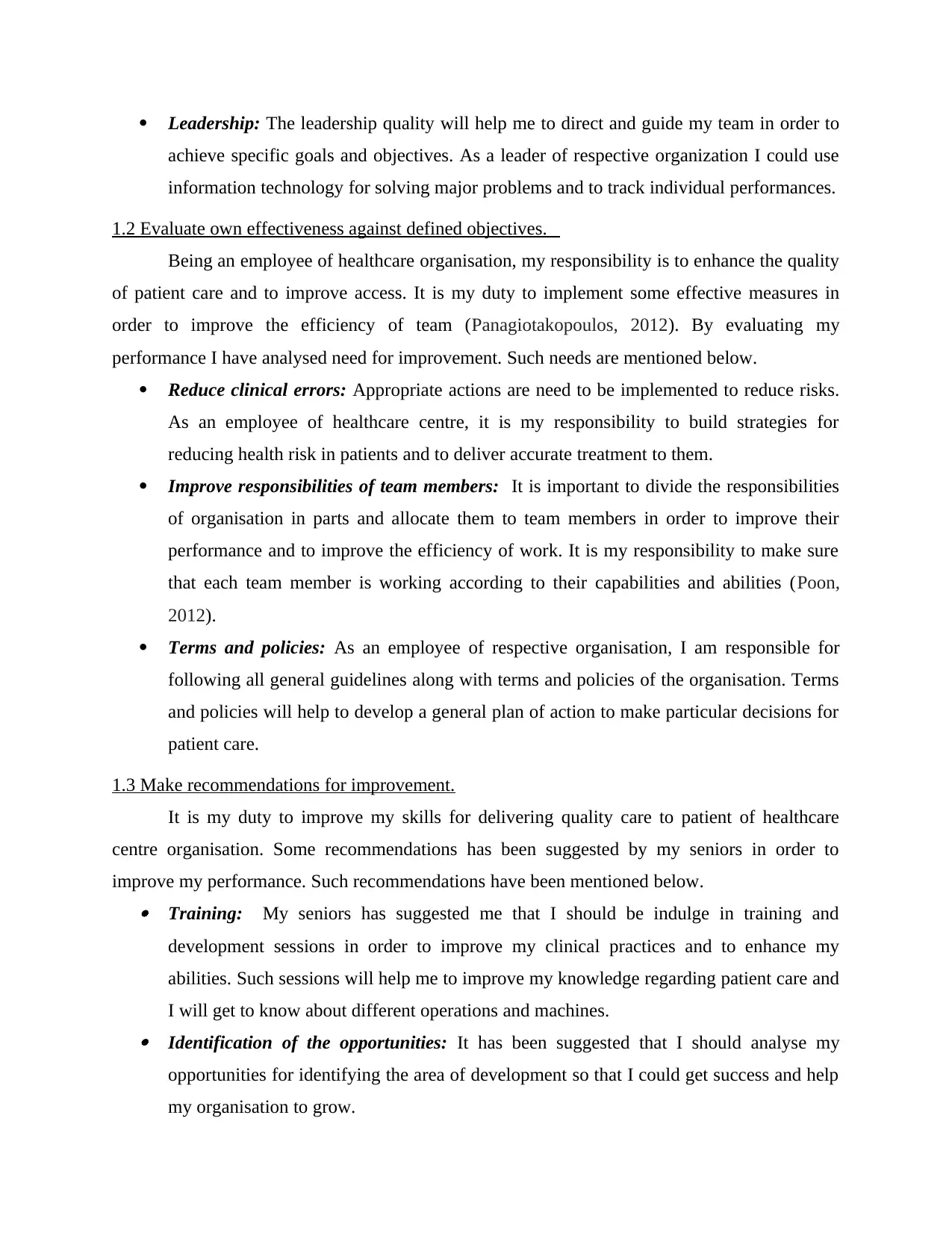
Leadership: The leadership quality will help me to direct and guide my team in order to
achieve specific goals and objectives. As a leader of respective organization I could use
information technology for solving major problems and to track individual performances.
1.2 Evaluate own effectiveness against defined objectives.
Being an employee of healthcare organisation, my responsibility is to enhance the quality
of patient care and to improve access. It is my duty to implement some effective measures in
order to improve the efficiency of team (Panagiotakopoulos, 2012). By evaluating my
performance I have analysed need for improvement. Such needs are mentioned below.
Reduce clinical errors: Appropriate actions are need to be implemented to reduce risks.
As an employee of healthcare centre, it is my responsibility to build strategies for
reducing health risk in patients and to deliver accurate treatment to them.
Improve responsibilities of team members: It is important to divide the responsibilities
of organisation in parts and allocate them to team members in order to improve their
performance and to improve the efficiency of work. It is my responsibility to make sure
that each team member is working according to their capabilities and abilities (Poon,
2012).
Terms and policies: As an employee of respective organisation, I am responsible for
following all general guidelines along with terms and policies of the organisation. Terms
and policies will help to develop a general plan of action to make particular decisions for
patient care.
1.3 Make recommendations for improvement.
It is my duty to improve my skills for delivering quality care to patient of healthcare
centre organisation. Some recommendations has been suggested by my seniors in order to
improve my performance. Such recommendations have been mentioned below. Training: My seniors has suggested me that I should be indulge in training and
development sessions in order to improve my clinical practices and to enhance my
abilities. Such sessions will help me to improve my knowledge regarding patient care and
I will get to know about different operations and machines. Identification of the opportunities: It has been suggested that I should analyse my
opportunities for identifying the area of development so that I could get success and help
my organisation to grow.
achieve specific goals and objectives. As a leader of respective organization I could use
information technology for solving major problems and to track individual performances.
1.2 Evaluate own effectiveness against defined objectives.
Being an employee of healthcare organisation, my responsibility is to enhance the quality
of patient care and to improve access. It is my duty to implement some effective measures in
order to improve the efficiency of team (Panagiotakopoulos, 2012). By evaluating my
performance I have analysed need for improvement. Such needs are mentioned below.
Reduce clinical errors: Appropriate actions are need to be implemented to reduce risks.
As an employee of healthcare centre, it is my responsibility to build strategies for
reducing health risk in patients and to deliver accurate treatment to them.
Improve responsibilities of team members: It is important to divide the responsibilities
of organisation in parts and allocate them to team members in order to improve their
performance and to improve the efficiency of work. It is my responsibility to make sure
that each team member is working according to their capabilities and abilities (Poon,
2012).
Terms and policies: As an employee of respective organisation, I am responsible for
following all general guidelines along with terms and policies of the organisation. Terms
and policies will help to develop a general plan of action to make particular decisions for
patient care.
1.3 Make recommendations for improvement.
It is my duty to improve my skills for delivering quality care to patient of healthcare
centre organisation. Some recommendations has been suggested by my seniors in order to
improve my performance. Such recommendations have been mentioned below. Training: My seniors has suggested me that I should be indulge in training and
development sessions in order to improve my clinical practices and to enhance my
abilities. Such sessions will help me to improve my knowledge regarding patient care and
I will get to know about different operations and machines. Identification of the opportunities: It has been suggested that I should analyse my
opportunities for identifying the area of development so that I could get success and help
my organisation to grow.
Paraphrase This Document
Need a fresh take? Get an instant paraphrase of this document with our AI Paraphraser
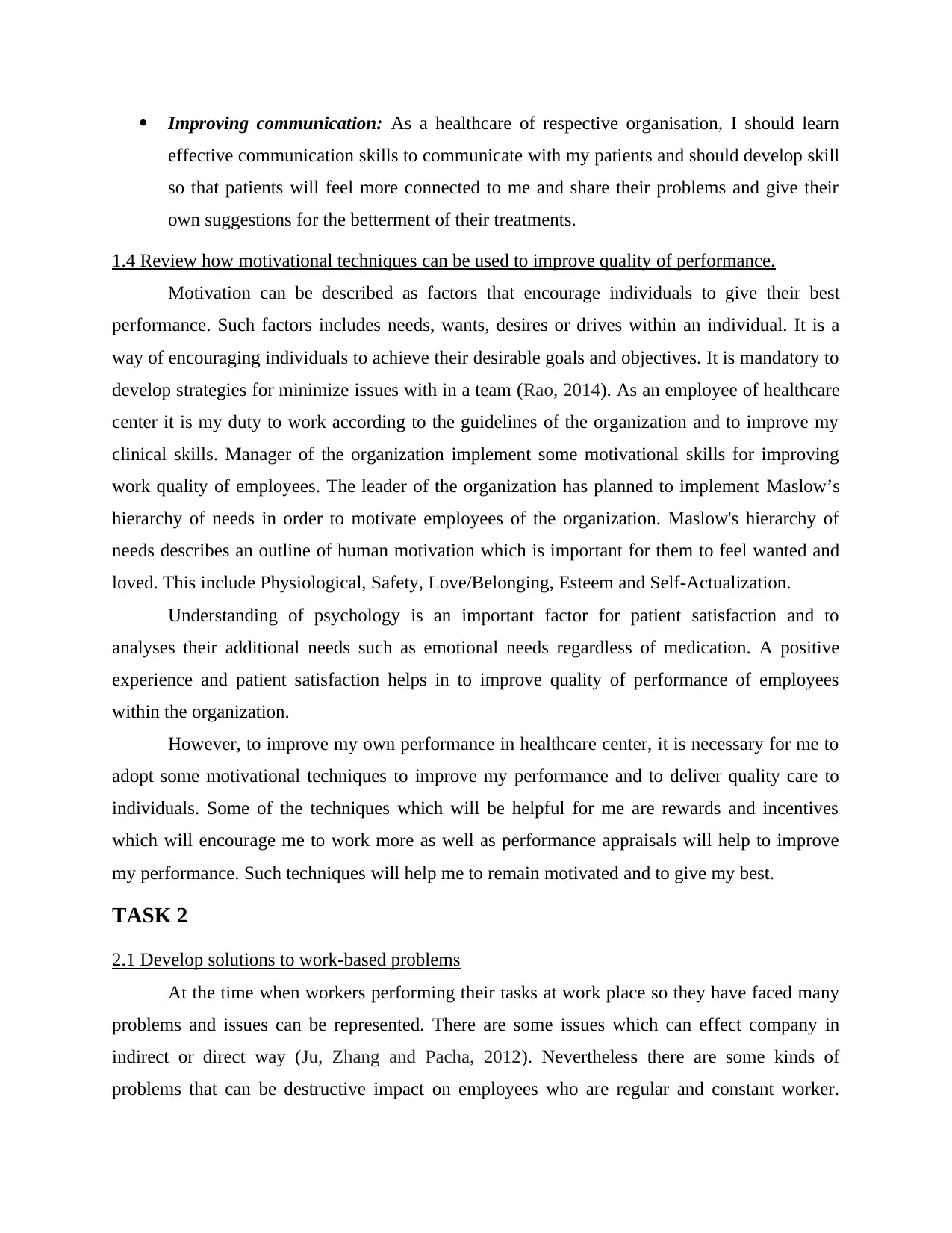
Improving communication: As a healthcare of respective organisation, I should learn
effective communication skills to communicate with my patients and should develop skill
so that patients will feel more connected to me and share their problems and give their
own suggestions for the betterment of their treatments.
1.4 Review how motivational techniques can be used to improve quality of performance.
Motivation can be described as factors that encourage individuals to give their best
performance. Such factors includes needs, wants, desires or drives within an individual. It is a
way of encouraging individuals to achieve their desirable goals and objectives. It is mandatory to
develop strategies for minimize issues with in a team (Rao, 2014). As an employee of healthcare
center it is my duty to work according to the guidelines of the organization and to improve my
clinical skills. Manager of the organization implement some motivational skills for improving
work quality of employees. The leader of the organization has planned to implement Maslow’s
hierarchy of needs in order to motivate employees of the organization. Maslow's hierarchy of
needs describes an outline of human motivation which is important for them to feel wanted and
loved. This include Physiological, Safety, Love/Belonging, Esteem and Self-Actualization.
Understanding of psychology is an important factor for patient satisfaction and to
analyses their additional needs such as emotional needs regardless of medication. A positive
experience and patient satisfaction helps in to improve quality of performance of employees
within the organization.
However, to improve my own performance in healthcare center, it is necessary for me to
adopt some motivational techniques to improve my performance and to deliver quality care to
individuals. Some of the techniques which will be helpful for me are rewards and incentives
which will encourage me to work more as well as performance appraisals will help to improve
my performance. Such techniques will help me to remain motivated and to give my best.
TASK 2
2.1 Develop solutions to work-based problems
At the time when workers performing their tasks at work place so they have faced many
problems and issues can be represented. There are some issues which can effect company in
indirect or direct way (Ju, Zhang and Pacha, 2012). Nevertheless there are some kinds of
problems that can be destructive impact on employees who are regular and constant worker.
effective communication skills to communicate with my patients and should develop skill
so that patients will feel more connected to me and share their problems and give their
own suggestions for the betterment of their treatments.
1.4 Review how motivational techniques can be used to improve quality of performance.
Motivation can be described as factors that encourage individuals to give their best
performance. Such factors includes needs, wants, desires or drives within an individual. It is a
way of encouraging individuals to achieve their desirable goals and objectives. It is mandatory to
develop strategies for minimize issues with in a team (Rao, 2014). As an employee of healthcare
center it is my duty to work according to the guidelines of the organization and to improve my
clinical skills. Manager of the organization implement some motivational skills for improving
work quality of employees. The leader of the organization has planned to implement Maslow’s
hierarchy of needs in order to motivate employees of the organization. Maslow's hierarchy of
needs describes an outline of human motivation which is important for them to feel wanted and
loved. This include Physiological, Safety, Love/Belonging, Esteem and Self-Actualization.
Understanding of psychology is an important factor for patient satisfaction and to
analyses their additional needs such as emotional needs regardless of medication. A positive
experience and patient satisfaction helps in to improve quality of performance of employees
within the organization.
However, to improve my own performance in healthcare center, it is necessary for me to
adopt some motivational techniques to improve my performance and to deliver quality care to
individuals. Some of the techniques which will be helpful for me are rewards and incentives
which will encourage me to work more as well as performance appraisals will help to improve
my performance. Such techniques will help me to remain motivated and to give my best.
TASK 2
2.1 Develop solutions to work-based problems
At the time when workers performing their tasks at work place so they have faced many
problems and issues can be represented. There are some issues which can effect company in
indirect or direct way (Ju, Zhang and Pacha, 2012). Nevertheless there are some kinds of
problems that can be destructive impact on employees who are regular and constant worker.
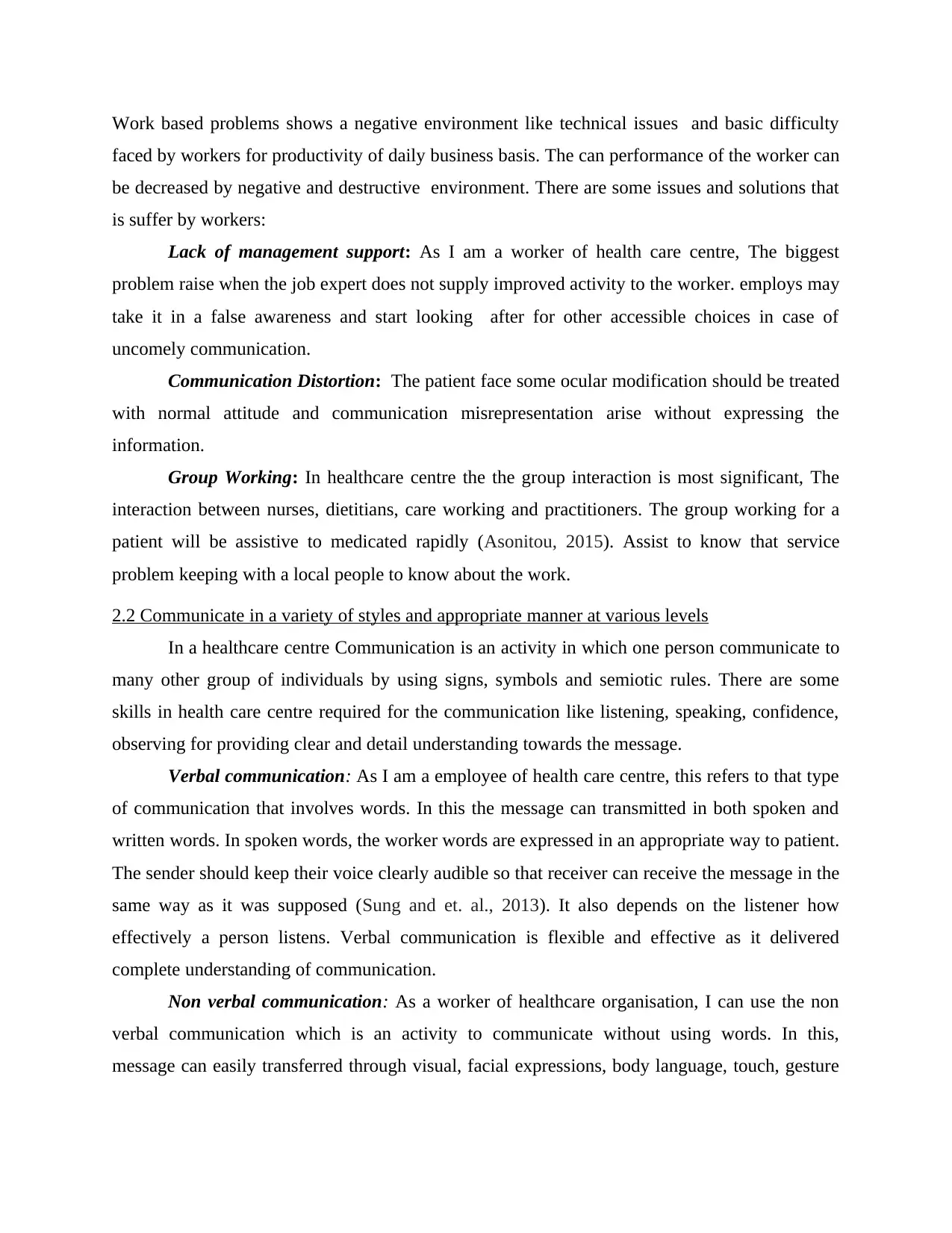
Work based problems shows a negative environment like technical issues and basic difficulty
faced by workers for productivity of daily business basis. The can performance of the worker can
be decreased by negative and destructive environment. There are some issues and solutions that
is suffer by workers:
Lack of management support: As I am a worker of health care centre, The biggest
problem raise when the job expert does not supply improved activity to the worker. employs may
take it in a false awareness and start looking after for other accessible choices in case of
uncomely communication.
Communication Distortion: The patient face some ocular modification should be treated
with normal attitude and communication misrepresentation arise without expressing the
information.
Group Working: In healthcare centre the the group interaction is most significant, The
interaction between nurses, dietitians, care working and practitioners. The group working for a
patient will be assistive to medicated rapidly (Asonitou, 2015). Assist to know that service
problem keeping with a local people to know about the work.
2.2 Communicate in a variety of styles and appropriate manner at various levels
In a healthcare centre Communication is an activity in which one person communicate to
many other group of individuals by using signs, symbols and semiotic rules. There are some
skills in health care centre required for the communication like listening, speaking, confidence,
observing for providing clear and detail understanding towards the message.
Verbal communication: As I am a employee of health care centre, this refers to that type
of communication that involves words. In this the message can transmitted in both spoken and
written words. In spoken words, the worker words are expressed in an appropriate way to patient.
The sender should keep their voice clearly audible so that receiver can receive the message in the
same way as it was supposed (Sung and et. al., 2013). It also depends on the listener how
effectively a person listens. Verbal communication is flexible and effective as it delivered
complete understanding of communication.
Non verbal communication: As a worker of healthcare organisation, I can use the non
verbal communication which is an activity to communicate without using words. In this,
message can easily transferred through visual, facial expressions, body language, touch, gesture
faced by workers for productivity of daily business basis. The can performance of the worker can
be decreased by negative and destructive environment. There are some issues and solutions that
is suffer by workers:
Lack of management support: As I am a worker of health care centre, The biggest
problem raise when the job expert does not supply improved activity to the worker. employs may
take it in a false awareness and start looking after for other accessible choices in case of
uncomely communication.
Communication Distortion: The patient face some ocular modification should be treated
with normal attitude and communication misrepresentation arise without expressing the
information.
Group Working: In healthcare centre the the group interaction is most significant, The
interaction between nurses, dietitians, care working and practitioners. The group working for a
patient will be assistive to medicated rapidly (Asonitou, 2015). Assist to know that service
problem keeping with a local people to know about the work.
2.2 Communicate in a variety of styles and appropriate manner at various levels
In a healthcare centre Communication is an activity in which one person communicate to
many other group of individuals by using signs, symbols and semiotic rules. There are some
skills in health care centre required for the communication like listening, speaking, confidence,
observing for providing clear and detail understanding towards the message.
Verbal communication: As I am a employee of health care centre, this refers to that type
of communication that involves words. In this the message can transmitted in both spoken and
written words. In spoken words, the worker words are expressed in an appropriate way to patient.
The sender should keep their voice clearly audible so that receiver can receive the message in the
same way as it was supposed (Sung and et. al., 2013). It also depends on the listener how
effectively a person listens. Verbal communication is flexible and effective as it delivered
complete understanding of communication.
Non verbal communication: As a worker of healthcare organisation, I can use the non
verbal communication which is an activity to communicate without using words. In this,
message can easily transferred through visual, facial expressions, body language, touch, gesture
⊘ This is a preview!⊘
Do you want full access?
Subscribe today to unlock all pages.

Trusted by 1+ million students worldwide
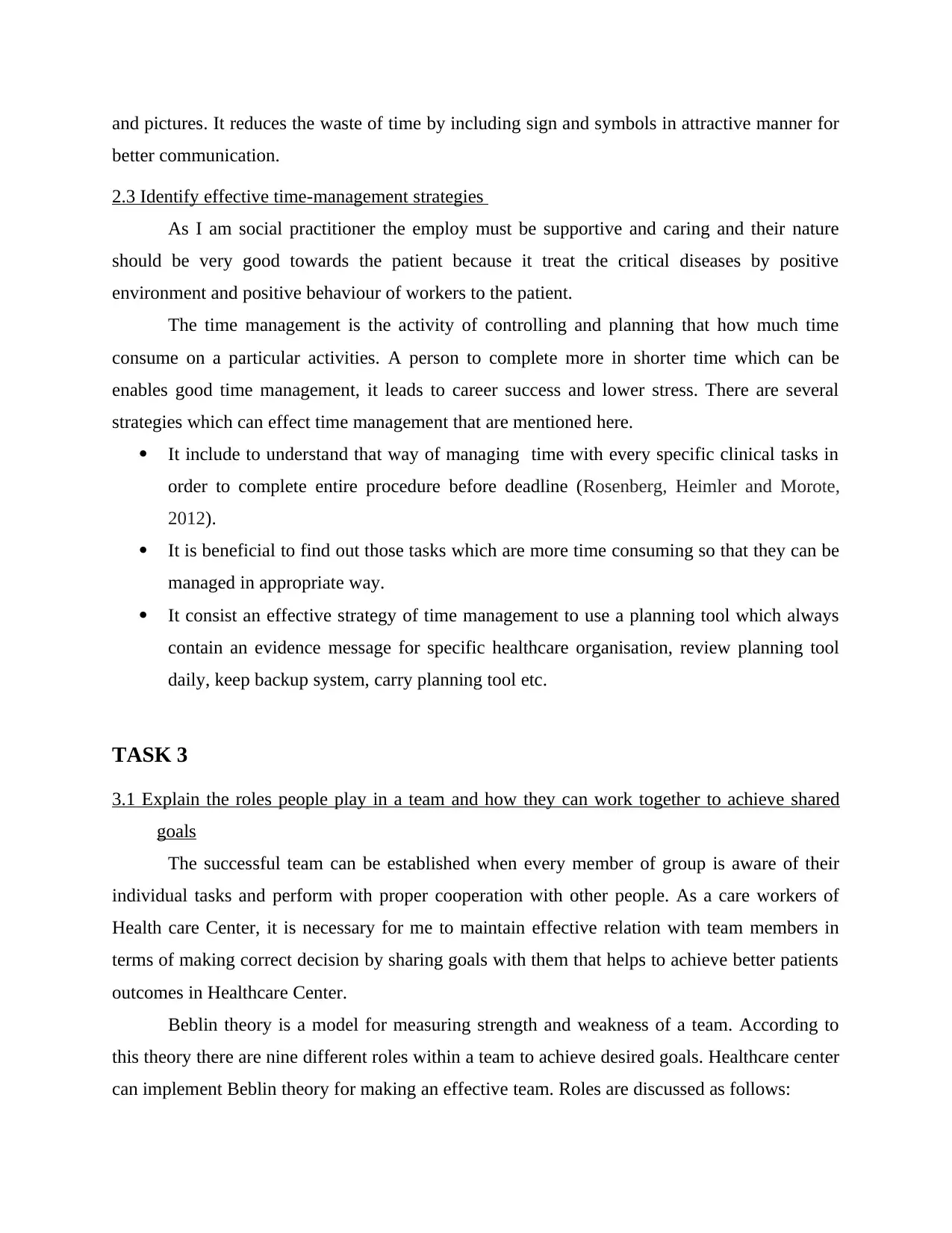
and pictures. It reduces the waste of time by including sign and symbols in attractive manner for
better communication.
2.3 Identify effective time-management strategies
As I am social practitioner the employ must be supportive and caring and their nature
should be very good towards the patient because it treat the critical diseases by positive
environment and positive behaviour of workers to the patient.
The time management is the activity of controlling and planning that how much time
consume on a particular activities. A person to complete more in shorter time which can be
enables good time management, it leads to career success and lower stress. There are several
strategies which can effect time management that are mentioned here.
It include to understand that way of managing time with every specific clinical tasks in
order to complete entire procedure before deadline (Rosenberg, Heimler and Morote,
2012).
It is beneficial to find out those tasks which are more time consuming so that they can be
managed in appropriate way.
It consist an effective strategy of time management to use a planning tool which always
contain an evidence message for specific healthcare organisation, review planning tool
daily, keep backup system, carry planning tool etc.
TASK 3
3.1 Explain the roles people play in a team and how they can work together to achieve shared
goals
The successful team can be established when every member of group is aware of their
individual tasks and perform with proper cooperation with other people. As a care workers of
Health care Center, it is necessary for me to maintain effective relation with team members in
terms of making correct decision by sharing goals with them that helps to achieve better patients
outcomes in Healthcare Center.
Beblin theory is a model for measuring strength and weakness of a team. According to
this theory there are nine different roles within a team to achieve desired goals. Healthcare center
can implement Beblin theory for making an effective team. Roles are discussed as follows:
better communication.
2.3 Identify effective time-management strategies
As I am social practitioner the employ must be supportive and caring and their nature
should be very good towards the patient because it treat the critical diseases by positive
environment and positive behaviour of workers to the patient.
The time management is the activity of controlling and planning that how much time
consume on a particular activities. A person to complete more in shorter time which can be
enables good time management, it leads to career success and lower stress. There are several
strategies which can effect time management that are mentioned here.
It include to understand that way of managing time with every specific clinical tasks in
order to complete entire procedure before deadline (Rosenberg, Heimler and Morote,
2012).
It is beneficial to find out those tasks which are more time consuming so that they can be
managed in appropriate way.
It consist an effective strategy of time management to use a planning tool which always
contain an evidence message for specific healthcare organisation, review planning tool
daily, keep backup system, carry planning tool etc.
TASK 3
3.1 Explain the roles people play in a team and how they can work together to achieve shared
goals
The successful team can be established when every member of group is aware of their
individual tasks and perform with proper cooperation with other people. As a care workers of
Health care Center, it is necessary for me to maintain effective relation with team members in
terms of making correct decision by sharing goals with them that helps to achieve better patients
outcomes in Healthcare Center.
Beblin theory is a model for measuring strength and weakness of a team. According to
this theory there are nine different roles within a team to achieve desired goals. Healthcare center
can implement Beblin theory for making an effective team. Roles are discussed as follows:
Paraphrase This Document
Need a fresh take? Get an instant paraphrase of this document with our AI Paraphraser

Shaper: The prior role of a shaper in respective organisation is to challenge the team and
to drive the team forward in order to deliver quality care to patients.
Implementer: The main objective of an implementer in healthcare centre is to make
strategies and plans to perform tasks (Andrews and Russell, 2012).
Finisher: The role of a finisher is to ensure that task has been completed and to analyse
errors or omissions with in operations.
Co-ordinator: Role of a co-ordinator in respective organisation is to plan and co-ordinate
the whole team and to make sure that implementation of all health policies and practices
are done properly.
Team-worker: The main role of a team worker is to ensure that team remain united and
work to resolve conflicts and issues within a team.
Resource investigator: The role of a resource investigator in healthcare centre is to
explore external resources and to make contacts on behalf of team.
Plant: The role of a plant is to solve difficult problems arising within healthcare
organisation.
Monitor evaluator: The major role of a monitor evaluator in respective organisation is to
ensure that all health activities are implemented as planned and desired outcomes has
achieved.
Specialist: Role of a specialist in respective organisation is to deliver quality care to
patients by using their technical skills and knowledge.
3.2 Analyse team dynamics
Tuckman theory describe relationship establishing between team members with maturity,
ability and leadership form. It requires challenges as the completion of task is requisite to
complete from beginning to end. Implementation of this theory in healthcare centre will help the
organisation to perform effectively and to develop skills of their team members. Stages of
Tuckman theory are discussed below.
Forming:- This is the first stage of the theory where team members start get to work and
starting know each other's skills, background and interest.
Storming stage:- In this the team members start sharing their ideas but sometimes it may
leads to conflicts (Benson, Morganand Filippaios, 2014).
to drive the team forward in order to deliver quality care to patients.
Implementer: The main objective of an implementer in healthcare centre is to make
strategies and plans to perform tasks (Andrews and Russell, 2012).
Finisher: The role of a finisher is to ensure that task has been completed and to analyse
errors or omissions with in operations.
Co-ordinator: Role of a co-ordinator in respective organisation is to plan and co-ordinate
the whole team and to make sure that implementation of all health policies and practices
are done properly.
Team-worker: The main role of a team worker is to ensure that team remain united and
work to resolve conflicts and issues within a team.
Resource investigator: The role of a resource investigator in healthcare centre is to
explore external resources and to make contacts on behalf of team.
Plant: The role of a plant is to solve difficult problems arising within healthcare
organisation.
Monitor evaluator: The major role of a monitor evaluator in respective organisation is to
ensure that all health activities are implemented as planned and desired outcomes has
achieved.
Specialist: Role of a specialist in respective organisation is to deliver quality care to
patients by using their technical skills and knowledge.
3.2 Analyse team dynamics
Tuckman theory describe relationship establishing between team members with maturity,
ability and leadership form. It requires challenges as the completion of task is requisite to
complete from beginning to end. Implementation of this theory in healthcare centre will help the
organisation to perform effectively and to develop skills of their team members. Stages of
Tuckman theory are discussed below.
Forming:- This is the first stage of the theory where team members start get to work and
starting know each other's skills, background and interest.
Storming stage:- In this the team members start sharing their ideas but sometimes it may
leads to conflicts (Benson, Morganand Filippaios, 2014).

Norming:- This stage refers that in this team members start resolving their issues and
socializing together but as the new task go on the team members back into storming phase.
Performing:- In this stage the team members are fully well-known with their team
without any conflict or resolve the issues positively.
Adjourning:- It include when project ends and team members disperse . Thus , this stage
is also known as mourning stage.
3.3 Suggest alternative ways to complete tasks and achieve team goals.
It is extremely acknowledged that workers must have potentiality and skills can modify
them to assure their improvement and growth in the healthcare center to achieve team goals.
There are several ways which are use by me for the achievement of team goals that are
mentioned below.
Setting Standard: In the healthcare center, I used to accomplish goals and completing
challenges in an impressive manner. It is necessary to set their definite standard over the work
which worker have to execute (de Guzman and Choi, 2013).
Action Planning: The action planning is the long time process in the healthcare, the
current level is average as well as communication and development skill process will raise this
process to attain desired objectives.
Motivating : It is required to motivate workers for ensuring the achievement of set traget
and goals on time in healthcare center.
TASK 4
4.1 Evaluate tools and methods for developing solutions to the problem
The problems are some harmful situations or matter which are needed to be resolved with
various solutions and methods so as to overcome with the issues raised by the problems. Solving
the problem is very essential in running the business and any organisation efficiently and
effectively. The methods and tools required to me to solve any raised problems aids in providing
methodical and structural approach. The basic duties of manger or team leader is to solve the
problems so as to make accurate decisions (Tymon, 2013). The key tools and methods which can
be used for resolving conflicts, making decisions, creating an innovative approach are mentioned
below.
socializing together but as the new task go on the team members back into storming phase.
Performing:- In this stage the team members are fully well-known with their team
without any conflict or resolve the issues positively.
Adjourning:- It include when project ends and team members disperse . Thus , this stage
is also known as mourning stage.
3.3 Suggest alternative ways to complete tasks and achieve team goals.
It is extremely acknowledged that workers must have potentiality and skills can modify
them to assure their improvement and growth in the healthcare center to achieve team goals.
There are several ways which are use by me for the achievement of team goals that are
mentioned below.
Setting Standard: In the healthcare center, I used to accomplish goals and completing
challenges in an impressive manner. It is necessary to set their definite standard over the work
which worker have to execute (de Guzman and Choi, 2013).
Action Planning: The action planning is the long time process in the healthcare, the
current level is average as well as communication and development skill process will raise this
process to attain desired objectives.
Motivating : It is required to motivate workers for ensuring the achievement of set traget
and goals on time in healthcare center.
TASK 4
4.1 Evaluate tools and methods for developing solutions to the problem
The problems are some harmful situations or matter which are needed to be resolved with
various solutions and methods so as to overcome with the issues raised by the problems. Solving
the problem is very essential in running the business and any organisation efficiently and
effectively. The methods and tools required to me to solve any raised problems aids in providing
methodical and structural approach. The basic duties of manger or team leader is to solve the
problems so as to make accurate decisions (Tymon, 2013). The key tools and methods which can
be used for resolving conflicts, making decisions, creating an innovative approach are mentioned
below.
⊘ This is a preview!⊘
Do you want full access?
Subscribe today to unlock all pages.

Trusted by 1+ million students worldwide
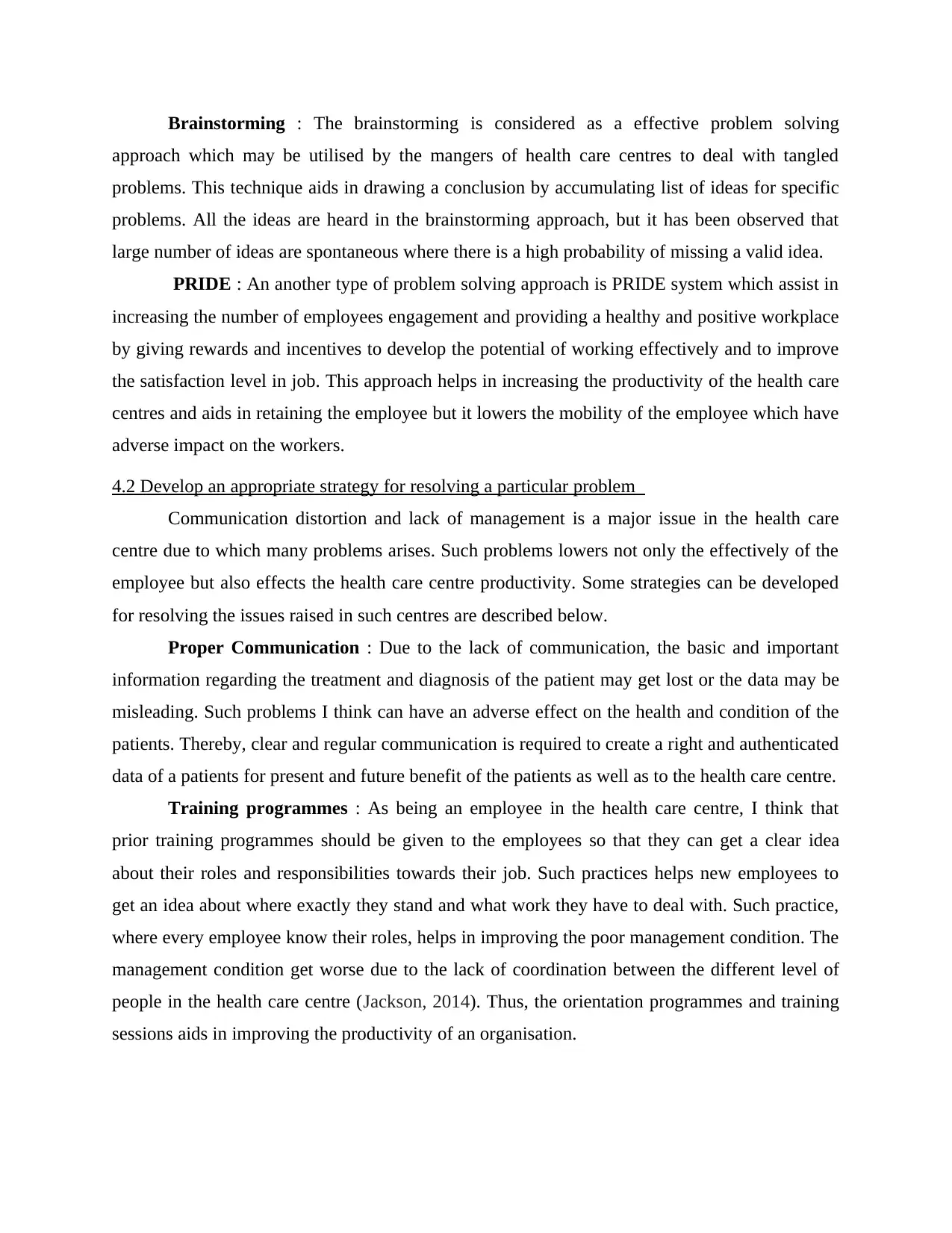
Brainstorming : The brainstorming is considered as a effective problem solving
approach which may be utilised by the mangers of health care centres to deal with tangled
problems. This technique aids in drawing a conclusion by accumulating list of ideas for specific
problems. All the ideas are heard in the brainstorming approach, but it has been observed that
large number of ideas are spontaneous where there is a high probability of missing a valid idea.
PRIDE : An another type of problem solving approach is PRIDE system which assist in
increasing the number of employees engagement and providing a healthy and positive workplace
by giving rewards and incentives to develop the potential of working effectively and to improve
the satisfaction level in job. This approach helps in increasing the productivity of the health care
centres and aids in retaining the employee but it lowers the mobility of the employee which have
adverse impact on the workers.
4.2 Develop an appropriate strategy for resolving a particular problem
Communication distortion and lack of management is a major issue in the health care
centre due to which many problems arises. Such problems lowers not only the effectively of the
employee but also effects the health care centre productivity. Some strategies can be developed
for resolving the issues raised in such centres are described below.
Proper Communication : Due to the lack of communication, the basic and important
information regarding the treatment and diagnosis of the patient may get lost or the data may be
misleading. Such problems I think can have an adverse effect on the health and condition of the
patients. Thereby, clear and regular communication is required to create a right and authenticated
data of a patients for present and future benefit of the patients as well as to the health care centre.
Training programmes : As being an employee in the health care centre, I think that
prior training programmes should be given to the employees so that they can get a clear idea
about their roles and responsibilities towards their job. Such practices helps new employees to
get an idea about where exactly they stand and what work they have to deal with. Such practice,
where every employee know their roles, helps in improving the poor management condition. The
management condition get worse due to the lack of coordination between the different level of
people in the health care centre (Jackson, 2014). Thus, the orientation programmes and training
sessions aids in improving the productivity of an organisation.
approach which may be utilised by the mangers of health care centres to deal with tangled
problems. This technique aids in drawing a conclusion by accumulating list of ideas for specific
problems. All the ideas are heard in the brainstorming approach, but it has been observed that
large number of ideas are spontaneous where there is a high probability of missing a valid idea.
PRIDE : An another type of problem solving approach is PRIDE system which assist in
increasing the number of employees engagement and providing a healthy and positive workplace
by giving rewards and incentives to develop the potential of working effectively and to improve
the satisfaction level in job. This approach helps in increasing the productivity of the health care
centres and aids in retaining the employee but it lowers the mobility of the employee which have
adverse impact on the workers.
4.2 Develop an appropriate strategy for resolving a particular problem
Communication distortion and lack of management is a major issue in the health care
centre due to which many problems arises. Such problems lowers not only the effectively of the
employee but also effects the health care centre productivity. Some strategies can be developed
for resolving the issues raised in such centres are described below.
Proper Communication : Due to the lack of communication, the basic and important
information regarding the treatment and diagnosis of the patient may get lost or the data may be
misleading. Such problems I think can have an adverse effect on the health and condition of the
patients. Thereby, clear and regular communication is required to create a right and authenticated
data of a patients for present and future benefit of the patients as well as to the health care centre.
Training programmes : As being an employee in the health care centre, I think that
prior training programmes should be given to the employees so that they can get a clear idea
about their roles and responsibilities towards their job. Such practices helps new employees to
get an idea about where exactly they stand and what work they have to deal with. Such practice,
where every employee know their roles, helps in improving the poor management condition. The
management condition get worse due to the lack of coordination between the different level of
people in the health care centre (Jackson, 2014). Thus, the orientation programmes and training
sessions aids in improving the productivity of an organisation.
Paraphrase This Document
Need a fresh take? Get an instant paraphrase of this document with our AI Paraphraser

4.3 Evaluate the potential impact on the business of implementing the strategy
The strategies which have been used to improve the distortion in the communication and
lack of management have a positive impact to a large extent on the health care centres. Thus, by
implementing the strategies, the organisation can retain the employee and can get the best out of
them. The impact of the implemented strategies are explained below.
Effective learning and training program: Training program will have positive impact
over business as it is considered as an effective techniques in enhancing skills and capability of
employees. This will help me in understanding my job role clearly so that I can perform by task
and job role in more effective and efficient manner. This will lead to increase overall
performance of business as well as its profitability. Training will help in improving knowledge to
perform a task which will lead to perform task in better way. This will motivate and encourage
employees to use their full potential as well as achieve desired goals of heath care centre.
Efficient communication effects : The communication is considered to render positive
impact on improving the misleading and misguided information regarding the patients. The
proper communication among the team members of health care centre influences the working
relationship qualities and enhancing the job satisfaction. Regular and clear communication has
also observed to have a intense impact on the safety of the patients (Suleman, 2016). The
interaction with the patients is also required to know the exact mental and social health status of
an individual, which later helps in mapping the disease and treatments procedure involved in
assessing the patient health. The proper communication also renders in getting the positive
consent of the patient required for undergoing treatments and medical tests on the patients. Such
practices lower the anxiousness of the patients about the treatment services, thus increasing the
effectiveness of the health care centre workers.
CONCLUSION
From the above assignment, it has been summarised that own responsibilities related
team work, communication, leadership are required to be completed for attaining desired goals.
It include use of effective strategy like training and effective communication which facilitate to
perform effectively as a care workers in an organization.
The strategies which have been used to improve the distortion in the communication and
lack of management have a positive impact to a large extent on the health care centres. Thus, by
implementing the strategies, the organisation can retain the employee and can get the best out of
them. The impact of the implemented strategies are explained below.
Effective learning and training program: Training program will have positive impact
over business as it is considered as an effective techniques in enhancing skills and capability of
employees. This will help me in understanding my job role clearly so that I can perform by task
and job role in more effective and efficient manner. This will lead to increase overall
performance of business as well as its profitability. Training will help in improving knowledge to
perform a task which will lead to perform task in better way. This will motivate and encourage
employees to use their full potential as well as achieve desired goals of heath care centre.
Efficient communication effects : The communication is considered to render positive
impact on improving the misleading and misguided information regarding the patients. The
proper communication among the team members of health care centre influences the working
relationship qualities and enhancing the job satisfaction. Regular and clear communication has
also observed to have a intense impact on the safety of the patients (Suleman, 2016). The
interaction with the patients is also required to know the exact mental and social health status of
an individual, which later helps in mapping the disease and treatments procedure involved in
assessing the patient health. The proper communication also renders in getting the positive
consent of the patient required for undergoing treatments and medical tests on the patients. Such
practices lower the anxiousness of the patients about the treatment services, thus increasing the
effectiveness of the health care centre workers.
CONCLUSION
From the above assignment, it has been summarised that own responsibilities related
team work, communication, leadership are required to be completed for attaining desired goals.
It include use of effective strategy like training and effective communication which facilitate to
perform effectively as a care workers in an organization.
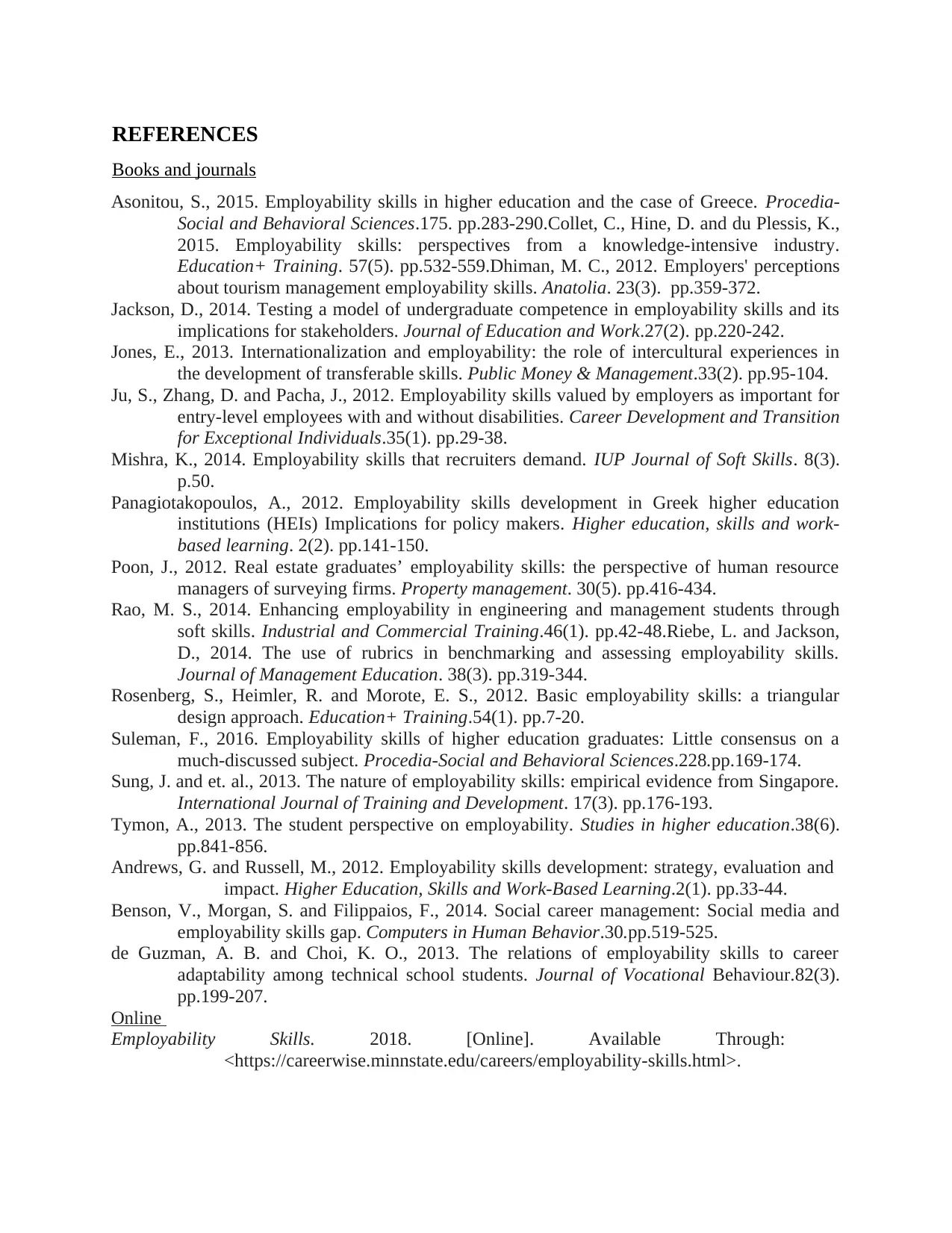
REFERENCES
Books and journals
Asonitou, S., 2015. Employability skills in higher education and the case of Greece. Procedia-
Social and Behavioral Sciences.175. pp.283-290.Collet, C., Hine, D. and du Plessis, K.,
2015. Employability skills: perspectives from a knowledge-intensive industry.
Education+ Training. 57(5). pp.532-559.Dhiman, M. C., 2012. Employers' perceptions
about tourism management employability skills. Anatolia. 23(3). pp.359-372.
Jackson, D., 2014. Testing a model of undergraduate competence in employability skills and its
implications for stakeholders. Journal of Education and Work.27(2). pp.220-242.
Jones, E., 2013. Internationalization and employability: the role of intercultural experiences in
the development of transferable skills. Public Money & Management.33(2). pp.95-104.
Ju, S., Zhang, D. and Pacha, J., 2012. Employability skills valued by employers as important for
entry-level employees with and without disabilities. Career Development and Transition
for Exceptional Individuals.35(1). pp.29-38.
Mishra, K., 2014. Employability skills that recruiters demand. IUP Journal of Soft Skills. 8(3).
p.50.
Panagiotakopoulos, A., 2012. Employability skills development in Greek higher education
institutions (HEIs) Implications for policy makers. Higher education, skills and work-
based learning. 2(2). pp.141-150.
Poon, J., 2012. Real estate graduates’ employability skills: the perspective of human resource
managers of surveying firms. Property management. 30(5). pp.416-434.
Rao, M. S., 2014. Enhancing employability in engineering and management students through
soft skills. Industrial and Commercial Training.46(1). pp.42-48.Riebe, L. and Jackson,
D., 2014. The use of rubrics in benchmarking and assessing employability skills.
Journal of Management Education. 38(3). pp.319-344.
Rosenberg, S., Heimler, R. and Morote, E. S., 2012. Basic employability skills: a triangular
design approach. Education+ Training.54(1). pp.7-20.
Suleman, F., 2016. Employability skills of higher education graduates: Little consensus on a
much-discussed subject. Procedia-Social and Behavioral Sciences.228.pp.169-174.
Sung, J. and et. al., 2013. The nature of employability skills: empirical evidence from Singapore.
International Journal of Training and Development. 17(3). pp.176-193.
Tymon, A., 2013. The student perspective on employability. Studies in higher education.38(6).
pp.841-856.
Andrews, G. and Russell, M., 2012. Employability skills development: strategy, evaluation and
impact. Higher Education, Skills and Work-Based Learning.2(1). pp.33-44.
Benson, V., Morgan, S. and Filippaios, F., 2014. Social career management: Social media and
employability skills gap. Computers in Human Behavior.30.pp.519-525.
de Guzman, A. B. and Choi, K. O., 2013. The relations of employability skills to career
adaptability among technical school students. Journal of Vocational Behaviour.82(3).
pp.199-207.
Online
Employability Skills. 2018. [Online]. Available Through:
<https://careerwise.minnstate.edu/careers/employability-skills.html>.
Books and journals
Asonitou, S., 2015. Employability skills in higher education and the case of Greece. Procedia-
Social and Behavioral Sciences.175. pp.283-290.Collet, C., Hine, D. and du Plessis, K.,
2015. Employability skills: perspectives from a knowledge-intensive industry.
Education+ Training. 57(5). pp.532-559.Dhiman, M. C., 2012. Employers' perceptions
about tourism management employability skills. Anatolia. 23(3). pp.359-372.
Jackson, D., 2014. Testing a model of undergraduate competence in employability skills and its
implications for stakeholders. Journal of Education and Work.27(2). pp.220-242.
Jones, E., 2013. Internationalization and employability: the role of intercultural experiences in
the development of transferable skills. Public Money & Management.33(2). pp.95-104.
Ju, S., Zhang, D. and Pacha, J., 2012. Employability skills valued by employers as important for
entry-level employees with and without disabilities. Career Development and Transition
for Exceptional Individuals.35(1). pp.29-38.
Mishra, K., 2014. Employability skills that recruiters demand. IUP Journal of Soft Skills. 8(3).
p.50.
Panagiotakopoulos, A., 2012. Employability skills development in Greek higher education
institutions (HEIs) Implications for policy makers. Higher education, skills and work-
based learning. 2(2). pp.141-150.
Poon, J., 2012. Real estate graduates’ employability skills: the perspective of human resource
managers of surveying firms. Property management. 30(5). pp.416-434.
Rao, M. S., 2014. Enhancing employability in engineering and management students through
soft skills. Industrial and Commercial Training.46(1). pp.42-48.Riebe, L. and Jackson,
D., 2014. The use of rubrics in benchmarking and assessing employability skills.
Journal of Management Education. 38(3). pp.319-344.
Rosenberg, S., Heimler, R. and Morote, E. S., 2012. Basic employability skills: a triangular
design approach. Education+ Training.54(1). pp.7-20.
Suleman, F., 2016. Employability skills of higher education graduates: Little consensus on a
much-discussed subject. Procedia-Social and Behavioral Sciences.228.pp.169-174.
Sung, J. and et. al., 2013. The nature of employability skills: empirical evidence from Singapore.
International Journal of Training and Development. 17(3). pp.176-193.
Tymon, A., 2013. The student perspective on employability. Studies in higher education.38(6).
pp.841-856.
Andrews, G. and Russell, M., 2012. Employability skills development: strategy, evaluation and
impact. Higher Education, Skills and Work-Based Learning.2(1). pp.33-44.
Benson, V., Morgan, S. and Filippaios, F., 2014. Social career management: Social media and
employability skills gap. Computers in Human Behavior.30.pp.519-525.
de Guzman, A. B. and Choi, K. O., 2013. The relations of employability skills to career
adaptability among technical school students. Journal of Vocational Behaviour.82(3).
pp.199-207.
Online
Employability Skills. 2018. [Online]. Available Through:
<https://careerwise.minnstate.edu/careers/employability-skills.html>.
⊘ This is a preview!⊘
Do you want full access?
Subscribe today to unlock all pages.

Trusted by 1+ million students worldwide
1 out of 13
Related Documents
Your All-in-One AI-Powered Toolkit for Academic Success.
+13062052269
info@desklib.com
Available 24*7 on WhatsApp / Email
![[object Object]](/_next/static/media/star-bottom.7253800d.svg)
Unlock your academic potential
Copyright © 2020–2025 A2Z Services. All Rights Reserved. Developed and managed by ZUCOL.



